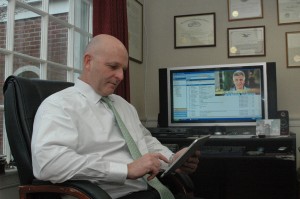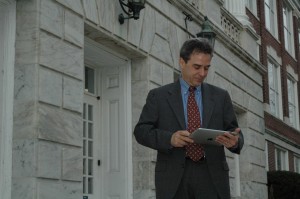Law 4G

The sight of lawyers trundling volumes of documents in and out of court is starting to become a thing of the past as legal data providers go paperless and more attorneys shrink their caseloads onto laptops and iPads.
“The advances in technology have totally transformed the practice of law,” said Stewart Casper, attorney and partner at Casper and de Toledo in Stamford. “It has made us immensely more efficient in the access to information. Legal research that once took hours now takes minutes.”
Mark Santagata, attorney and partner at Cacace, Tusch and Santagata in Stamford, said the efficiencies go far beyond having a fast computer and the use of email.
“We”™ve been dependent on computers for a long time now, but more and more lawyers are running around with documents in their pockets,” Santagata said, referring to the advent of smartphones, tablets and mini hard drives.
Michael Jones, attorney and litigation department chair at Ivey, Barnum and O”™Mara in Greenwich, said the influx of technology in the world of law over the past few years marks the most significant change in law process since the arrival of the LexisNexis document data centers in the late 1970s.
“That was the advent of database research,” Jones said. The majority of libraries that typically line the walls of law firms today are in place for show, he said. “Everything that we do is online now, the statute books are the last remaining vestige of books that are actually picked up.”
Jones said the technological updates have saved firms significant money in yearly updates of Law Reporter subscriptions.
“From an economical standpoint, law library updates used to cost a fortune,” Jones said. “Some of the subscriptions were five to ten thousand dollars a year just for a single reporter.”
Even though law-research providers such as WestLaw have carried their subscription fees over, they have been kept down by services such as the state-run “Connecticut Case Base,” a free online reporter for Connecticut cases and statutes.

Recently, applications created specifically for lawyers have been released for the iPad. Leading the way is TrialPad, an $89 application developed by LegalTech in Manhattan. The application allows lawyers to control evidence presentations, highlight and annotate documents in an image able to be projected, as well as organize thousands of documents for use in trial. The TrialPad has recently integrated DropBox, a file transfer service allowing new files to be quickly uploaded. Other apps like RLTC Evidence and Exhibit A have followed TrialPad into the genre.
“You”™re seeing these technologies more and more in the courtroom,” Jones said. “You”™re seeing more and more iPads and tablets. The time when we”™re downloading directly to our tablets for trial preparation is essentially here. Eventually that”™s where all your documents will be, you won”™t see lawyers carting in all their materials.”
While Stamford Courthouse is one of the newer and most technologically equipped in the area, there are many others that need to catch up.
“In Stamford, the switch to paperless law records last year was a great advance,” Jones said. “It used to be common to call up a court and find the file was lost, it was getting to be an epidemic; now that is much less common.”
Jones said there are also judges who have begun to implement technology on the bench. He said Connecticut Superior Court Judge Kevin Tierney in Stamford and U.S. Bankruptcy Judge Alan Shiff in Bridgeport are known for having their laptops alongside them in court, often doing research of their own as a trial is under way.
“You really have to be on top of your game in that kind of environment,” Jones said.
Santagata said the use of these technologies has become necessary.
“Dealing with judges who can request points of information at a moment”™s notice becomes a much more immediate and efficient process,” he said. “Having the information at your fingertips is a great asset. That kind of power is going to have an impact as to what”™s going on in front of the court at that moment, and that”™s unbelievably significant and has a very real effect as to the pace at which things move in the courtroom.”
Santagata said the effect of constantly being connected has also increased the expectations of judges and clients. He said he is concerned about the process eventually not respecting the human element.
“If you”™re instantaneously expected to argue, that could be a dramatic change to how things are done,” Santagata said. “I think it would be a mistake to make a courtroom function as quickly as it possibly can. That kind of analysis cannot happen in a second and you want to make sure you”™re not compromising the intellectual exercise.”
Casper, Santagata and Jones have all seen an influx in the use of digital recreations in the courtroom.
Santagata said it is becoming more common for lawyers to retain reproduction artists to work with them to recreate the integral scenarios of particular cases.
“You could see where a lawyer who has an animated recreation would have a better ability to demonstrate something another attorney could only describe through witnesses,” Santagata said.
Jones said he has himself done video editing for the use in cases.
“Five years ago very few people were videotaping depositions,” Jones said. “But it can have a very real effect when you see people reacting on the screen. You can distill a lot of information and tell very poignantly what”™s going on in a much more real way than if it”™s written in a transcript.”
Jones said that can mean the difference between if a settlement is accepted or not.
“The technology has become part of the art of persuasion,” said Casper who often does litigation in the medical field frequently uses graphic recreations in his courtroom presentations.
“In the old days we would say a picture is worth a thousand words, now it”™s much more than that.”